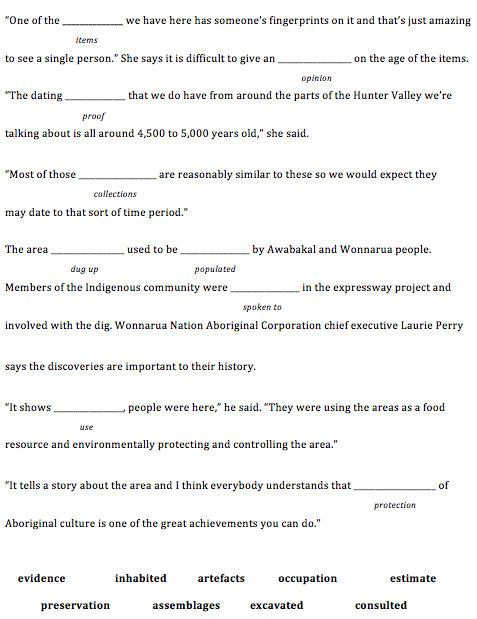Cloze passages are useful in helping students learn important reading skills, such as backward and forward referencing to make meaning within the context (Dufficy, 2005, p. 107). Three types of cloze passage have been designed using this article from the ABC website:
- Reverse cloze is particularly useful for learning about grammar and language features, as the inclusion of additional words requires students to select the correct tense, connective, adjective, noun or preposition. This provides real context as “words and phrases only mean what they mean in the context of the sentences and texts that they appear in” (ACARA, 2014). The constraint is for students to reach a consensus on the word they think makes the most sense, in pairs. The focus on adjectives in the selected task builds vocabulary and encourages students to draw meaning from context. It also gets students to focus on the correct use of the article ‘an’ in selecting from ‘an criminal/an medical/an archaeological’ and syntax in selecting from ‘mainly on busy/big/elevated areas’. It could be used partway through a unit of work to assess their learning of Aboriginal Australian history as some content-specific knowledge assists in this task.
- In a synonym cloze, words that are likely to be new to most children are replaced with a more common synonym. This assists them with new words and subject-specific vocabulary (Dufficy, 2005). This task could be followed up with a discussion on etymology. Understanding the historical evolution of language can explain many of the spelling anomalies in English, and provides additional opportunities for students to remember and comprehend new vocabulary (ACARA, 2014).

- A prediction cloze can focus student’s attention on a particular aspect of language or a particular issue prior to reading. This task ensures that the exploration of different words takes students closer to the author’s intentions and meaning. In this example, the focus is on drawing attention to the emotions and perspectives on the side of the NSW Government, the archaeologists and the local Aboriginal community. Bringing this activity back to the whole class allows for discussion about the meaning that can be gained from different words being selected and why each side might feel the way they do.

For related posts, see the one on flowcharts, one on ranking tasks and sequencing tasks, one on prediction activities, and another on clines.
References
ACARA. (2014). English as an Additional Language or Dialect Teacher Resource. Australian Curriculum, Assessment and Reporting Authority. Sydney: ACARA. Retrieved from http://www.acara.edu.au/verve/_resources/EALD_Overview_and_Advice_revised_February_2014.pdf
Dufficy, P. (2005). Designing Learning for Diverse Classrooms. Newtown PETAA.

